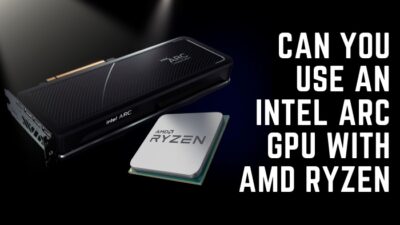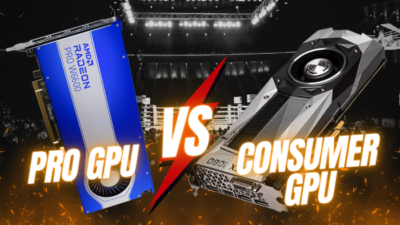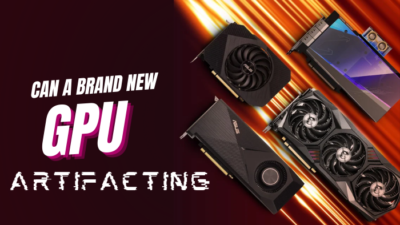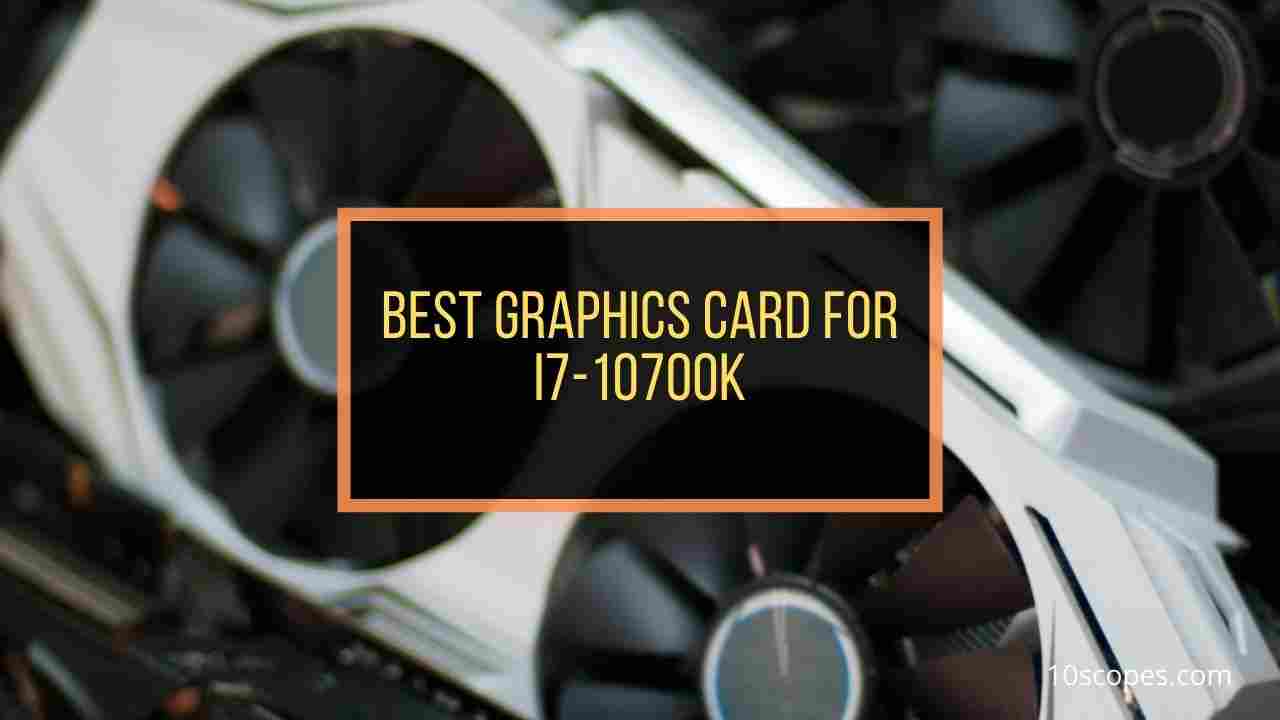Making sure that your GPU is configured properly can be the difference between a day and light when running games. If you have incorrect settings applied, you will get shockingly low frame rates.
No one wants that, right? To help you maximize the potential of your graphics card, you can follow this guide and set the correct settings accordingly.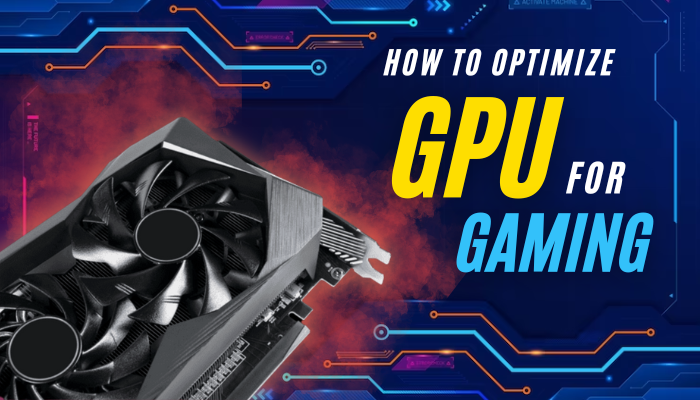
So, let’s look at what settings I am talking about and start the optimizations.
How to Optimize GPU for Gaming?
First, ensure that your GPU is adequate at running the game that you want. Let’s take Hogwarts Legacy for example. You need at least an NVIDIA GTX 960 or AMD RX 470 to run this game. Use anything less powered, and you will get low frame rates and choppy gameplay.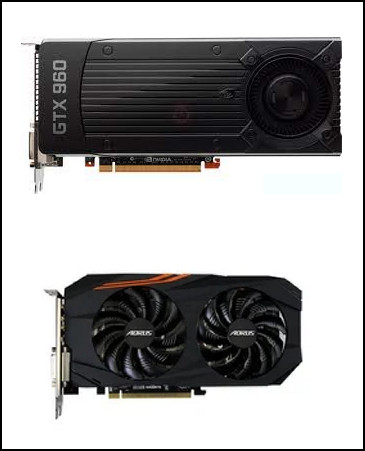
Nowadays a mid-range card such as RTX 3060 can handle the demands of modern gaming pretty well at 1080p. Even if you have something a bit less powerful, you will be okay.
So, let’s look at what changes need to be done.
These are the ways you can optimize your GPU for gaming:
Update GPU Drivers
Always install the latest graphics drivers for your GPU. They will either fix a bug prevalent with a game or improve your gaming experience. Now do not expect your 3060 to perform at the same levels as an RTX 3080 after an update. But the gaming experience will get better and be consistent.
Before installing it like any other software, it is better to uninstall it using DDU(Device Driver Uninstaller). This is great freeware that removes the leftover files from the previous installation. Then you can install the new drivers and there will be no conflicts between two different software versions.
Download the latest video drivers from the link provided below.
Set the Correct Resolution and Refresh Rate
The next step would be to check if Windows is set to the correct resolution and refresh rate.
While you can change this from the in-game settings, you must enable a high refresh rate from the Windows Settings. Otherwise, even if your system is capable of driving 160 fps, you will be locked to 60Hz and won’t get to enjoy the fluid experience.
Follow these steps to set a high refresh rate on Windows:
- Press Windows + I to open Settings.
- Click on Display and set the Display Resolution to the desired resolution. Typically this is 1080p and 4K for high-end displays.
- Now go to Advanced Display Settings.
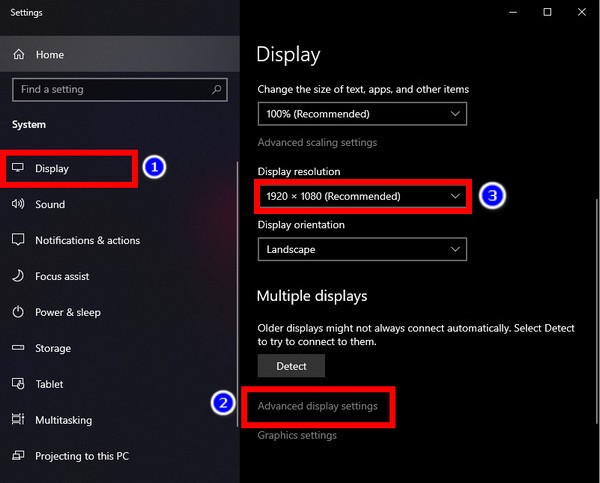
- Under Refresh Rate choose the maximum value shown here.
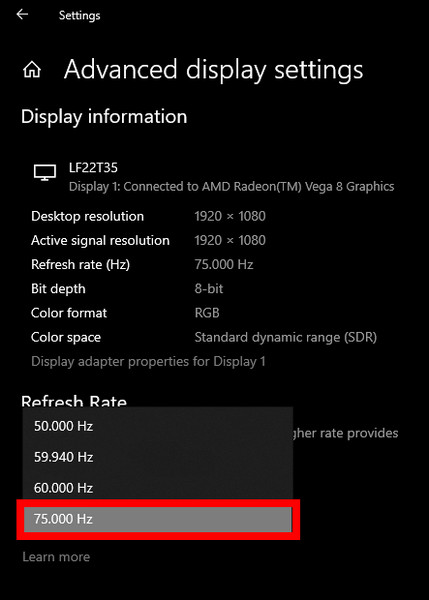
- If the above step doesn’t work for you, click on Display adapter properties.
![win-10-display-adapter-properties]](https://10scopes.com/wp-content/uploads/2023/03/win-10-display-adapter-properties.jpg)
- In the new dialog box, click on the Monitor tab. Here select the Screen refresh rate to your monitor’s refresh rate.
- Click Ok when done.
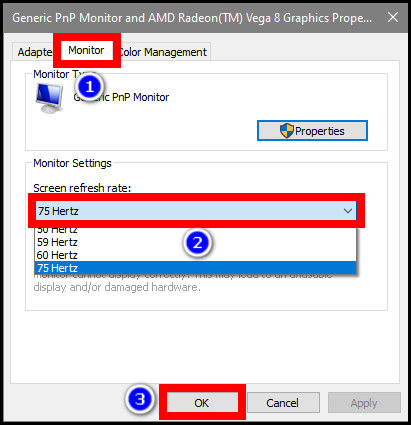
Now your monitor should run at its native high refresh rate.
We compare the super and Ti GPU lineups from NVIDIA. If looking to purchase a new GPU, this article should come in handy for you.
Enable G-SYNC or FreeSync
If there is a disparity between the frame rates generated by the GPU and the refresh rate of your display, you will experience screen tearing. There will be a time delay between each frame which will cause image tearing on your screen.
To avoid this from happening, both AMD and NVIDIA use anti-screen tearing technology. You can enable them right from their respective drivers.
Follow these steps to enable NVIDIA G-SYNC from NVIDIA Control Center:
- Right-click on your Desktop and open the NVIDIA Control Panel.
- Click on Set up G-SYNC under Display.
- Check the box near Enable G-SYNC. Also, select Enable for fullscreen mode.
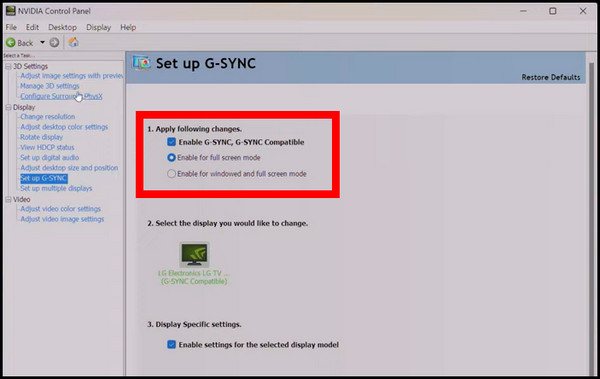
- Now click on Manage 3D Settings.
- Find Vertical Sync and turn it On.
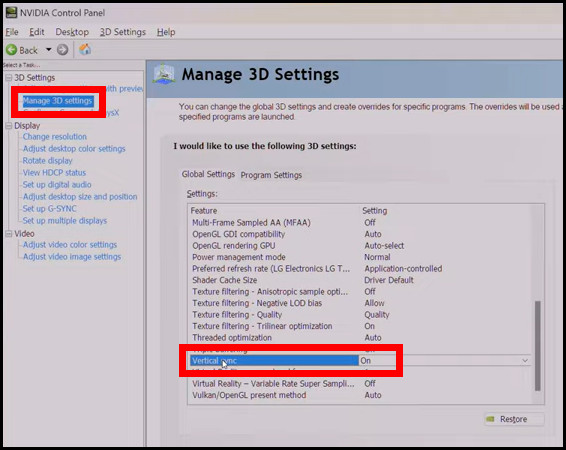
Now you will not encounter such screen tearing as before.
For AMD graphics cards, the option to enable FreeSync is present inside AMD’s Adrenaline Software.
These are the steps to enable AMD FreeSync from AMD Software:
- Right-click on your Desktop and open AMD Adrenaline Software.
- Now click the gear icon.
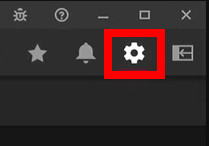
- Go to Display.
- Turn on the toggle next to AMD FreeSync.
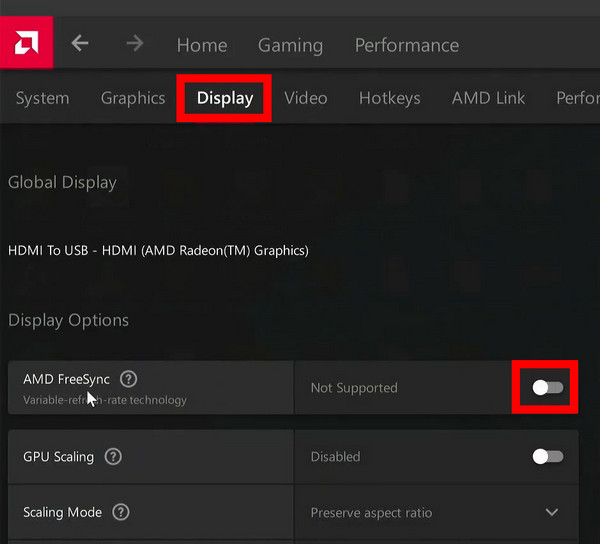
- Now click on the Graphics tab at the top.
- Scroll down and find Vertical Refresh. Set it to Always on.
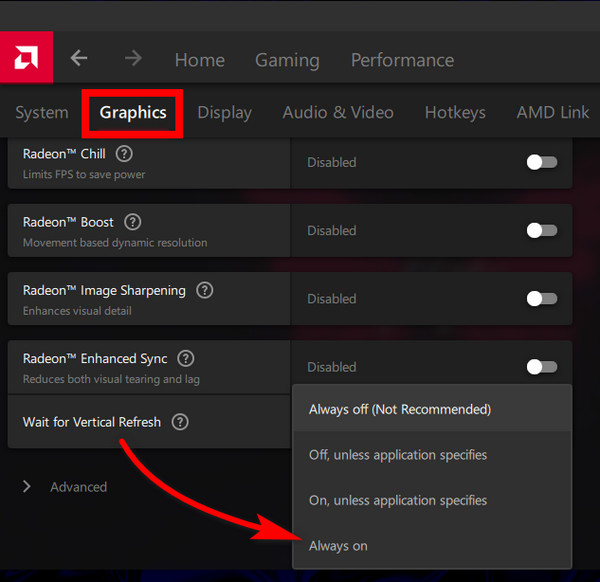
Even if your GPU pushes out more frames than what your display can show, you will not see any tearing.
Although FreeSync is an AMD proprietary technology, you may wonder whether it works with NVIDIA cards. Our separate article covers this exact interest. Do check it out.
Tweak 3D Settings
There are multiple settings that you can change to improve frame rates in your games. Most of these are present inside the Graphics Settings of every game. You can experiment with them and look at which gives you the best performance.
But if you want the game to determine the best settings based on your hardware, select Auto preset and you are good to go.
However, there are some global settings that you can enforce right from your GPU driver. That way, the game will run without any interference. Let’s look at which ones you need to tweak.
| Settings | Recommended Action |
|---|---|
| Anioscopic Filtering | 16X |
| Anti-Aliasing FXAA | On |
| Anti-Aliasing Mode | Application Controlled |
| Power Management Mode | Maximum Performance |
| Ambient Occlusion | Performance |
| Open GL Rendering | Set your GPU |
| Texture Filtering - Quality | High-Performance |
| Texture Filtering - Negative LOD Bias | Off |
| Texture Filtering - Trilinear Optimization | On |
| Low Latency Mode | Ultra |
For an NVIDIA GPU, you can find these options under 3D Settings in the NVIDIA Control Panel.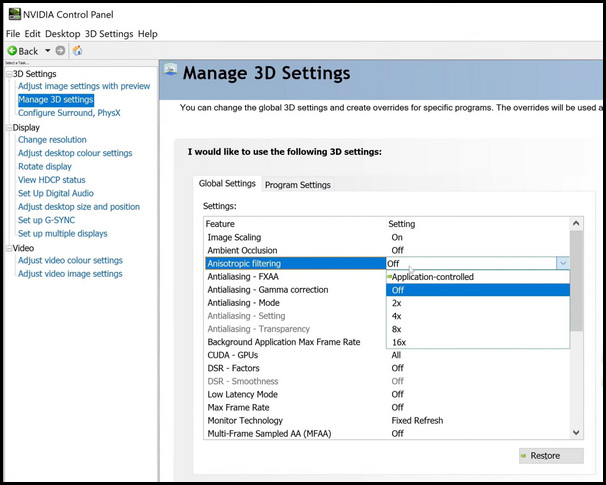
Similarly, AMD has these options present under the Graphics section of its AMD Software.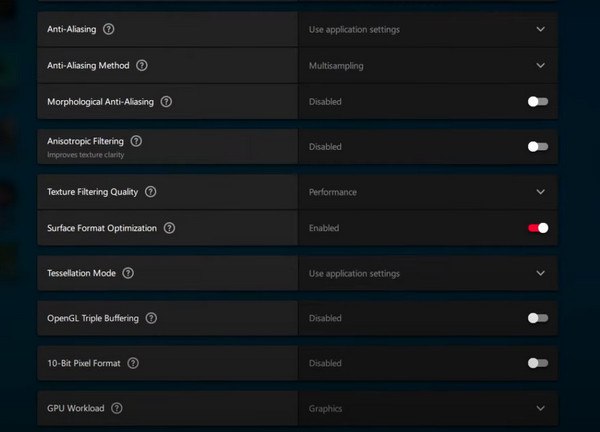
Apart from these settings, there are additional options to tweak from. But I felt you can already change those from inside your favorite games.
GPUs are getting bulkier day by day and the RTX 4090 is a prime example of it. This can introduce strain on your Motherboard. To resolve this, read our separate article on how to fix GPU sag.
Reduce Latency
Both GPU manufacturers have solutions aiming to cut down on latency experienced during gaming. They are NVIDIA Reflex or AMD Anti Lag respectively.
When you see a delay between your movement in-game and the respective frame generation, that is caused by system latency. The anti-lag solution designed by AMD or NVIDIA aims to cut this down by stopping the GPU from maxing out. This typically reduces the CPU’s speed so that the game does not remain bound to the GPU.
When a game maxes out your GPU, then the CPU will be waiting to send more frames to the render cache every time you shoot a bullet or jump in-game. The solution is to reduce the GPU’s load so that the frame buffer remains empty and frames are generated almost instantly when arriving.
While you can use Anti-Lag or NVIDIA’s Reflex, there is an alternative to reducing the latency to the lowest value. Just cap the framerate to the nearest maximum value that your display can show. That way, the GPU will never hit 100% utilization and the latency will be lowest.
For example, if you use a 144 Hz display, you can set the frame cap to 140 fps in competitive shooters and 60 fps in story-based titles. It ensures smooth gameplay and constant frame rates.
Checking whether a game is CPU or GPU-intensive can help you better choose your GPU. Read our separate article where we focus on this topic.
Enable DLSS or FSR
Image upscaling is a great way of improving performance as you run games in higher resolution. The images are rendered in a higher or lower resolution and then mapped to the native resolution of your display.
NVIDIA’s solution which is DLSS (full for Deep Learning Super Sampling), uses native tensor cores while AMD’s FSR (Fidelity FX Super Resolution) implements a software-based upscaling.
Both solutions are supported by many games, which you can easily enable by going into Settings and selecting the different upscaling techniques that they offer.
The main difference between these modes is the resolutions at which the image is upscaled. Either you go for a higher frame rate and sacrifice some image quality or choose a better image in your games.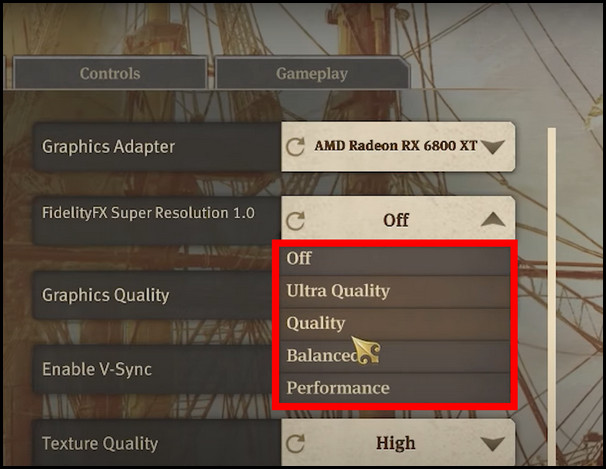
For DLSS, you must have an NVIDIA RTX GPU with dedicated tensor cores. But as AMD’s solution is software-based, you can basically use it on any graphics card as long as the game supports it.
Enable Fullscreen Mode
Always set your games to Fullscreen mode to minimize dropped frames. Some games may perform better with Windowed mode while others work well with borderless. But in my experience, I have found the fullscreen mode to give me the most frame rates in games.
Here is an option inside Fortnite that enables Fullscreen mode.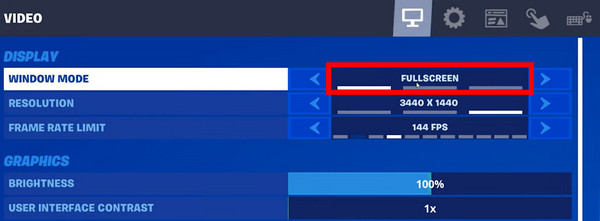
This is present in basically every game. All you need to do is select it or turn it on.
Looking for the ultimate guide on ray tracing? Look no further than our article where we enable ray tracing on RTX cards.
Disable Game Modes and Overlays
If you have set up game overlays to monitor the frame rates or provide you with in-game statistics, they will use up some of your system’s resources. They are mostly CPU dependent though.
But you wouldn’t want to lose out on every tiny bit of performance, would you?
So, it is ideal to close overlays such as Windows’ Game Bar. Also, close any background application before launching any game. Aim to free up as many system resources as you can. That will ensure that your in-game performance is not affected.
Frequently Asked Questions
How do I set my GPU to max performance?
To set your NVIDIA GPU to the Maximum performance, open NVIDIA Control Center and go to Configure 3D Settings. Then set Power Management to Maximum Performance.
How to boost fps in games?
To boost fps in games using your existing GPU, ensure that it is running the latest drivers. Then reduce the graphical settings that are taxing to your graphics cards. Anti-aliasing is something that you should go after. If you are still experiencing lags, reduce the resolution to 720p.
Conclusion
So, there you go. All the optimizations that you can perform on your end to get the max out of your GPU. But this is not the end. There are other ways to increase a GPU’s performance such as overclocking, but that is out of the scope of today’s article.
Always remember that a game developer can actually improve FPS on a specific GPU if they optimize a game properly. So if a game is performing poorly, chances are you would get it fixed by patches coming in the future.
Until that time, you are good to go with the settings mentioned above.
So, get your battlestation ready and let the gaming sessions commence.

